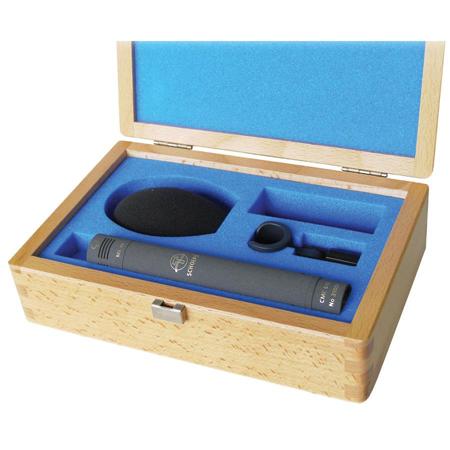
Overview
Compare
Q&A
Questions & Answers
Reviews about this item
Review Summary
About Schoeps CMC641
The Schoeps CMC641C Wide Cardioid Microphone Kit includes CMC 6U Amplifiers, MK41 Supercardioid Capsule, SG20 Stand Clamps and B5 Popscreens in a Custom Wood Box. The Schoeps CMC 6 Amplifier is designed for standard 48- and 12-Volt phantom powering. Its circuitry recognizes the supply voltage and adjusts itself automatically. Its performance characteristics remain essentially the same either way; mainly, the difference is that the current drawn at 12 Volts is greater than at 48 Volts. However, the 12-Volt mode consumes less power and might be preferred for battery-powered recording.
The microphone amplifier provides the electrostatic charge which the capsule requires in order to produce a signal. Since only a minuscule amount of current is contained in this signal, amplification of the current is required. To avoid interference to the signal on the way from the microphone to the input of the mixer or preamp, the signal is conveyed at low impedance and in balanced form. The CMC 6 amplifier offers a symmetrical, transformerless, direct-coupled Class A output stage with low impedance, low distortion and high freedom from interference.
The Schoeps MK41 is part of the Colette series of modular capsules designed for use with the CMC6 preamplifier. Sound arriving from off axis is attenuated even more than with a standard cardioid. The pickup is "drier" and less susceptible to acoustic feedback, provided there isn't a strong sound source directly on the rear axis of the microphone. Its directivity is highly independent of frequency, so that even sounds arriving off axis and reverberant sound are registered without coloration. Consequently, even distant placement of the microphone produces a very natural sound pickup.
The Sanken SG20 Microphone Stand Adapter is designed to stand-mount Sanken Microphones measuring 0.78" (20mm) in diameter. The SG20 features a swivel action for flexible positioning.
The Schoeps B5 Solid Foam Popscreen is an acoustic foam close-speech popscreen that provides sufficient protection at normal speaking distances for cardioids and other directional capsules, especially when speech capsules are used. With omnidirectional capsules, it may even be used outdoors in light wind. This popscreen has minimal effect on sound quality.
Key Features
- CMC 6U: Flat frequency response
- Extremely low noise and distortion
- Balanced, very low-impedance output
- Can be used with very long cables
- Well-protected against RFI
- For use w 12V or 48V phantom powering
What's in the box:
- Schoeps CMC 6U Amplifiers
- MK41 Supercardioid Capsule
- SG20 Microphone Adapter Stand Clamp with Swivel Action
- B 5 Solid Foam Popscreen
- Wooden Box
- Schoeps 2 Year Warranty